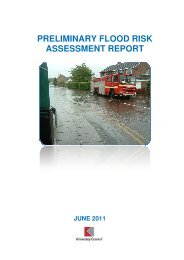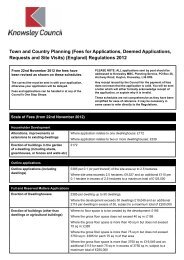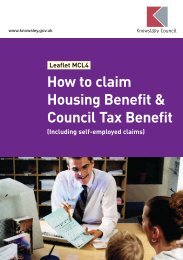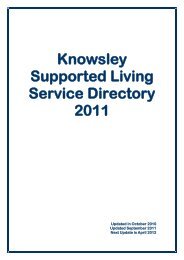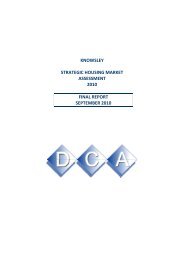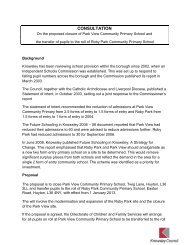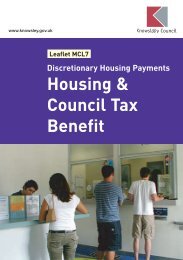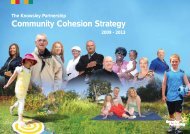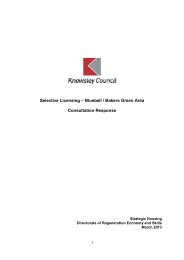Knowsley Replacement Unitary Development Plan - Knowsley Council
Knowsley Replacement Unitary Development Plan - Knowsley Council
Knowsley Replacement Unitary Development Plan - Knowsley Council
You also want an ePaper? Increase the reach of your titles
YUMPU automatically turns print PDFs into web optimized ePapers that Google loves.
GREEN BELT AND THE RURAL ECONOMY<br />
GREEN BELT AND THE RURAL ECONOMY<br />
9.21<br />
The <strong>Council</strong> intends to prepare a landscape<br />
character assessment, in accordance with best<br />
practice advice from the Countryside Agency, and<br />
may produce a Supplementary <strong>Plan</strong>ning Document<br />
which will identify:<br />
• Guidelines for the design and location of new<br />
buildings and other development in the<br />
Green Belt;<br />
• The key landscape, bio-diversity and ecological<br />
qualities of the Green Belt which will need to be<br />
protected and enhanced; and<br />
• The circumstances in which the <strong>Council</strong> may ask<br />
developers to enhance the rural landscape.<br />
IMPACT OF NEW DEVELOPMENT ON THE WIDER<br />
AMENITIES OF THE COUNTRYSIDE<br />
9.22<br />
<strong>Knowsley</strong>’s countryside provides a valuable resource<br />
for outdoor recreation and outdoor sport activities<br />
(such as fishing, walking, cycling and informal<br />
recreation). The Borough contains three golf courses,<br />
as well as large country parks at Stadt Moers Park<br />
and Halewood Park and an award winning Local<br />
Nature Reserve at Acornfield <strong>Plan</strong>tation. Many people<br />
live in or run businesses in the countryside (such as<br />
riding establishments) which are dependent on a<br />
quiet and disturbance free environment.<br />
9.23<br />
New development will generally be resisted where it<br />
would cause noise or other disturbance which may<br />
spoil the enjoyment of those who live in the<br />
countryside, or use it for business or recreational<br />
purposes. <strong>Development</strong> will, however, be encouraged<br />
if it would provide opportunities for increasing the<br />
awareness and availability of outdoor recreation and<br />
outdoor sport activity opportunities.<br />
POLICY LINKS<br />
Policy DQ1<br />
“Design Quality in New <strong>Development</strong>”<br />
Policy ENV1<br />
“Control of Pollution in New <strong>Development</strong>”<br />
Policy ENV3<br />
“Light Pollution”<br />
Policy ENV9<br />
“Protection of Habitats and Designated Sites”<br />
POLICY G3:<br />
AGRICULTURAL LAND<br />
1. New development involving the loss of best and<br />
most versatile agricultural land (Grades 1, 2 or<br />
3A) in a way which would practically prevent it<br />
from future return to agricultural use, will not<br />
be permitted unless:<br />
a) It has been demonstrated that the<br />
development cannot be accommodated on<br />
previously developed land or on land within<br />
the boundaries of an urban area; and<br />
b) It has been demonstrated that sufficient<br />
land of lower agricultural quality is<br />
unavailable or if available should not be<br />
developed in preference taking into account<br />
landscape, wildlife, historic or<br />
archaeological considerations.<br />
2. New development proposals which, whilst not<br />
directly causing the loss of best and most<br />
versatile agricultural, would effectively prevent<br />
the use of such land as a result of the<br />
fragmentation of holdings or the conversion of<br />
agricultural buildings to other uses will also be<br />
subject to the requirements of 1 above.<br />
EXPLANATION G3<br />
9.24<br />
The Department for Environment, Food and Rural<br />
Affairs (DEFRA) classifies agricultural land according<br />
to its quality. Land within grades 1, 2 and 3a is known<br />
as “best and most versatile”. Agricultural land in<br />
Grades 3b, 4 and 5 is of moderate or poor quality and<br />
is less significant in terms of the national agricultural<br />
interest. The majority of the agricultural land in<br />
<strong>Knowsley</strong> is classified as “best and most versatile”,<br />
and is therefore subject to policy G3.<br />
9.25<br />
New developments can, in effect, destroy the quality<br />
of agricultural land, making it impossible to use it as<br />
a resource in the future. This is the case with<br />
proposals for new buildings as well as for many<br />
“soft” end uses such as golf courses (which can<br />
rarely practicably be returned to agricultural use).<br />
In some cases, although the development itself may<br />
not be located on high quality land, it may sterilise<br />
the use of land by fragmenting agricultural holdings<br />
or converting buildings needed to farm the land to<br />
other uses, unconnected with agriculture.<br />
9.26<br />
Non-agricultural developments (such as new<br />
recreational or tourism uses) can themselves have a<br />
valuable role to play in diversifying the rural economy<br />
and can also provide an opportunity for enhancing the<br />
landscape. Policy G3 therefore does not seek to<br />
prevent such uses being permitted in principle.<br />
However, where they would affect best and most<br />
versatile land the onus will be on developers to<br />
demonstrate (using information submitted with the<br />
planning application) that the proposed development<br />
cannot be accommodated on previously developed<br />
sites or on land of lower agricultural quality.<br />
Where alternative sites are available on lower graded<br />
land, regard should be given to whether the<br />
alternative sites have a landscape, wildlife, historic or<br />
archaeological value which would mean that they are<br />
unsuitable for the proposed development.<br />
POLICY LINKS<br />
Policy G1<br />
“<strong>Development</strong> within the Green Belt”<br />
Policy G2<br />
“Landscape Character and Amenities of the Green<br />
Belt”<br />
Policy G4<br />
“Rural Diversification”<br />
POLICY G4:<br />
RURAL DIVERSIFICATION<br />
1. Proposals for the diversification of rural<br />
enterprises will be permitted provided that<br />
they would:<br />
a) Preserve the openness and purposes of the<br />
Green Belt;<br />
b) Not harm the visual amenity or character<br />
of the area; and<br />
c) Otherwise be in accordance with the<br />
policies of this <strong>Plan</strong>.<br />
EXPLANATION G4<br />
9.27<br />
Appropriate proposals for rural diversification can<br />
help to maintain a good quality and diverse<br />
landscape, protecting a valuable resource and<br />
supporting economic activity. The <strong>Council</strong> recognises<br />
that diversification into non-agricultural activities can<br />
be vital to the continuing viability of many farm<br />
enterprises. Rural diversification shall be<br />
encouraged where it contributes to sustainable<br />
development objectives and preserves the openness<br />
of the Green Belt and does not conflict the purpose of<br />
including land within it.<br />
9.28<br />
Where rural diversification requires buildings, the<br />
<strong>Council</strong> encourages the re-use or replacement of<br />
existing buildings. Where farm diversification<br />
proposals in the Green Belt would result in<br />
“in-appropriate” development in terms of <strong>Plan</strong>ning<br />
102<br />
KNOWSLEY REPLACEMENT UNITARY DEVELOPMENT PLAN: Adopted June 2006<br />
KNOWSLEY REPLACEMENT UNITARY DEVELOPMENT PLAN: Adopted June 2006<br />
103



